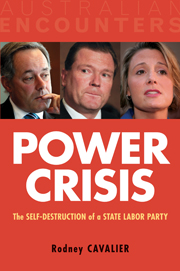Book contents
- Frontmatter
- Contents
- Australian Encounters with the ALP
- Preface
- Acknowledgements
- Introduction
- 1 NSW Labor and its leaders
- 2 Death below
- 3 The rise of Morris Iemma
- 4 Annual Conference, May 2008
- 5 Morris Iemma falls
- 6 The protracted fall of Nathan Rees
- Epilogue: Does party membership matter?
- Appendix A NSW ALP branches closed 1999–2009
- Appendix B NSW ALP financial membership 2002–09
- Appendix C Delegates to NSW ALP Annual Conference, May 2008
- Sources
- Index
- Australian Encounters series
- Forthcoming titles in the Australian Encounters series
3 - The rise of Morris Iemma
Published online by Cambridge University Press: 10 January 2011
- Frontmatter
- Contents
- Australian Encounters with the ALP
- Preface
- Acknowledgements
- Introduction
- 1 NSW Labor and its leaders
- 2 Death below
- 3 The rise of Morris Iemma
- 4 Annual Conference, May 2008
- 5 Morris Iemma falls
- 6 The protracted fall of Nathan Rees
- Epilogue: Does party membership matter?
- Appendix A NSW ALP branches closed 1999–2009
- Appendix B NSW ALP financial membership 2002–09
- Appendix C Delegates to NSW ALP Annual Conference, May 2008
- Sources
- Index
- Australian Encounters series
- Forthcoming titles in the Australian Encounters series
Summary
Giuseppe and Maria Iemma arrived in Australia in 1960. The young couple, recently married, had departed their village in Calabria, what had been their whole world. Within a year their only child was born – a son, Maurizio, who became known outside the family as Morris. When Morris was six, the family moved from the inner-city to Beverly Hills in Sydney's southern suburbs, where they have lived all the years since. The Iemma parents both worked, a variety of jobs in car building, textiles, print shops. Getting and keeping work was often hard with English language difficulties.
Giuseppe had been a communist in a country which enjoyed the largest Communist Party membership outside the Iron Curtain. He did not abandon his faith in a new country. Both parents valued politics and political discussion. Morris Iemma grew up in a household where politics was the staple of discussion. More than discussion; it was a household which believed in collective action to protect the worker in his or her place of work and believed in the possibility of reform by political action. It was a household in which an emerging Gough Whitlam was the hero. Giuseppe took his son to Whitlam rallies. He kept a close eye on the Labor leader in newspapers. Television and radio delivered the Labor leader into the household. In 1974 the Iemmas took Australian citizenship as a tribute to their hero.
- Type
- Chapter
- Information
- Power CrisisThe Self-Destruction of a State Labor Party, pp. 59 - 89Publisher: Cambridge University PressPrint publication year: 2010



